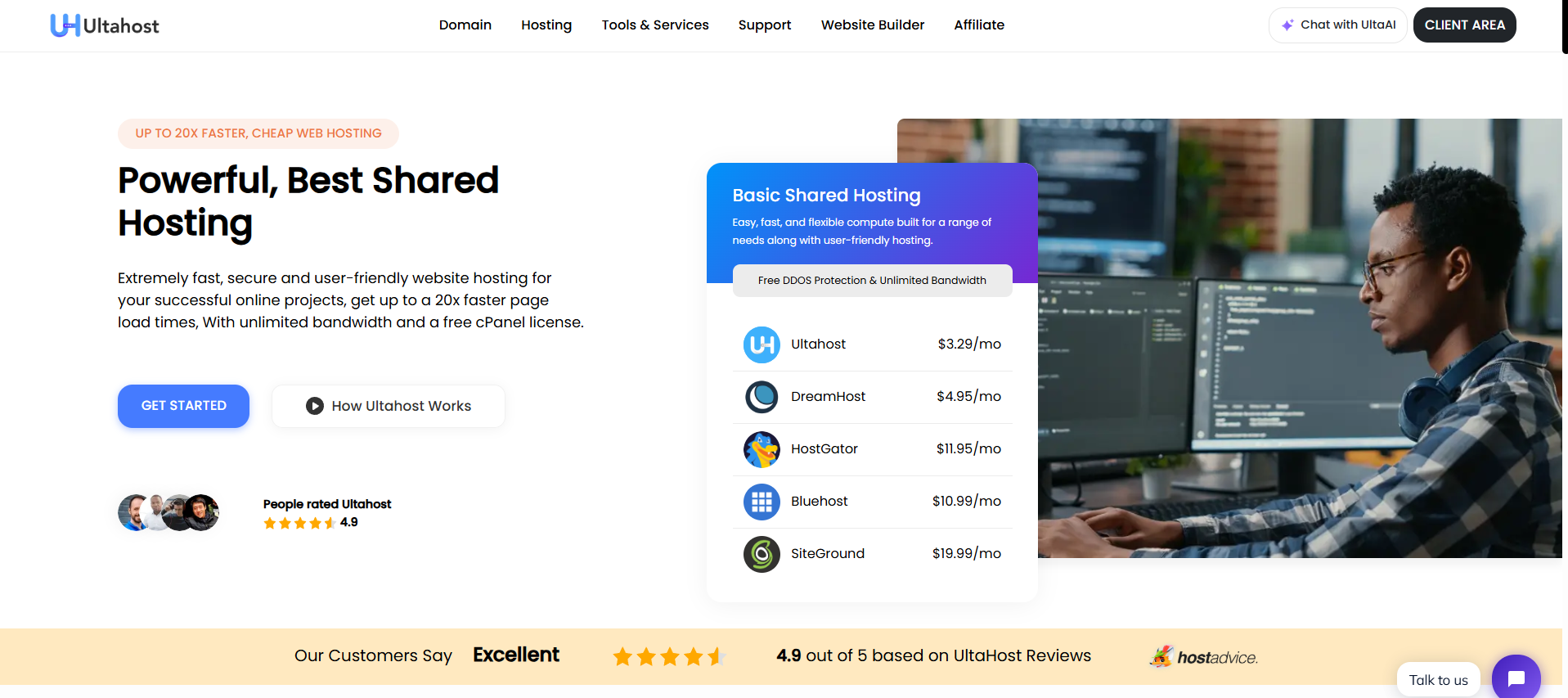In this UltaHost review, I’ll share with you my thoughts on the host’s features, pricing, support, as well as do a real-time test to measure important performance metrics that matter for your website. Let’s dive in!
Founded in 2018, Ultahost is a hosting greenhorn and one of the youngest on the market. However, the company has grown quite significantly and is starting to get on the radar of webmasters looking for the next best solution for their needs.
Ultahost holds a remarkable 4.9-star rating from 1013 reviews on Hostadvice, highlighting that a vast majority of its users are exceptionally pleased with its offerings, especially noting its superior services and user-friendliness. Ultahost does not have a BBB rating despite being a U.S. company. However, on Trustpilot, they rate 4.6/5.0 from over 272 reviews.
Ultahost offers shared hosting, VPS, WordPress, a hybrid VDS (virtual dedicated), full-blown dedicated and reseller. They also offer email hosting plus other niche-specific packages like social network hosting and ecommerce hosting.
In my view, Ultahost is ideal for small to medium-sized businesses and individual site owners, including bloggers, needing reliable, secure hosting. It’s also well-suited for e-commerce platforms and developers seeking advanced hosting options like VPS and dedicated servers for greater control and customization.
UltaHost may not be the best fit for large enterprises with complex, specialized needs, or those with very minimal hosting needs.
Ultahost Features
- Free domain & SSL
- Free daily backups & migration
- SSD servers
- Real-time malware protection
- Multi-panel support
Ultahost offers a ton of great features but what really makes it stand out are its highly transparent pricing plans and all the freebies that come out-of-the-box.
Many hosts offer discounted prices that renew at much higher prices after the first year. Ultahost’s pricing plans are transparent and billed either monthly or annually.
Learn more about Ultahost:
Ultahost Performance
The performance of any host you are considering is one important factor to consider. And what performance metrics matter the most for your website? And how do you get an average measurement of a host’s performance?
Speed; uptime; and average load times!
- Speed measures how quickly the servers send data to a user visiting your website.
- Uptime measures how much of the time your host’s servers are online.
- Load time measures how quickly your web pages are fully loaded and functional.
Google recommends a fully loaded time of 1-2 seconds for the best results.
I tested Ultahost’s performance on GTMetrix by running the host’s domain through the tool. To get more accurate results, it’d be better to use a website hosted on Ultahost but I couldn’t find any despite asking the help agents.
Well, these were the results:
On GTMetrix, Ultahost.com had a great response time and an overall performance of 98%, well above the average
Level Of Support
And here comes the good part. Ultahost has a very healthy support hub providing help 24/7 via:
Live chat

A human live chat box is always a relief in this era of bots and automated responses. The agent joined in less than 30 seconds which is very impressive. They answered most of my questions and were courteous. My only issue with the live chat was the portal closed once I minimized the browser window.
Phone
Ultahost offers support via its helplines available in the U.S.A and Turkey (where they were found). I tried calling the line but couldn’t reach them from Nigeria (where I’m writing this from).

Ultahost offers email support – which is becoming scarce among other providers:

Ticket
As an extension of the host’s email support, you can also open support tickets with agents assigned to your case until you find a solution:

To open a support ticket, all you need to put in is your name, email, phone number and then any details you want to share.
Video guides
Another rare support gem many other hosts don’t provide – maybe because it takes some effort to create –video guides. As a visual learner, I always appreciate detailed video tutorials that explain complex ideas in plain English and Ultahost does just that:

Knowledgebase
And finally, the good old knowledgebase with a built-in search engine sifting through hundreds of FAQs and getting-started guides:

User-Friendliness – Ease of use
How easy is it to get started with Ultahost and set up the basic tools and apps? Let’s find out!
Registration
Want to get started on Ultahost? Simply pay for one of their plans, fill in the details and you’re good to go.
Using their shared plans as an example, click ‘Order’:

Next, choose whether you want to register a new domain or use an existing domain you have. Fill in the domain name and extension (.com, .net, etc.) and move forward.
Ultahost allows you to choose several payment plans – monthly, quarterly, semi-annually, annually, biennially, or triennially. Pick one, choose your server location, the kind of SSL certificate, whether you want their free website builder, and any extra addon.

Click ‘Continue’ and proceed to the checkout page.
Here, fill in your payment details, your account details, any extra add-ons and proceed.

And voila! You’d have an account on the host and can confirm your details in an email sent to you.
Ultahost control panel

After joining the platform, you’d be able to access your client dashboard and from here, 1-click access to the host’s modern cPanel. Ultahost uses cPanel for all its backend tweaks:

Giving you control over your domains, email, databases and other mission-critical functions.
Installing WordPress on Ultahost
The quickest and most convenient way to install WordPress on your Ultahost account is to sign up for one of the host’s WordPress plans. On every WordPress plan, you get automatic WordPress installs, a WordPress staging tool, WordPress plugins, and WordPress backup tools.
Adding an email on Ultahost
You can create and add an email to your domain name in your cPanel account on Ultahost.
Once you’re in, navigate to ‘Email Accounts’ under ‘Email’. Click ‘CREATE’ and fill in the necessary email info – address, domain it will be tied to, password, mailbox size, and finally, choose ‘Do not automatically create folders’:

Click ‘Create’ and it’s done!






